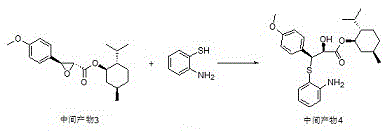Selective synthesis method of diltiazem chiral intermediate
A technology for chiral intermediates and diltiazem, which is applied in the field of selective synthesis of diltiazem chiral intermediates, can solve the problem of high cost and achieve the effects of improving yield, improving utilization rate and reducing cost
- Summary
- Abstract
- Description
- Claims
- Application Information
AI Technical Summary
Problems solved by technology
Method used
Image
Examples
preparation example Construction
[0036] The selective synthesis method of diltiazem chiral intermediate of the present invention, such as Figure 1 to Figure 5 As shown, anisaldehyde is used as the main raw material, firstly condensed with the intermediate product 1 formed by the reaction of chloroacetyl chloride and L-menthol, and after purification, it reacts with o-aminothiophenol and undergoes hydrolysis and cyclization steps to obtain the diltiazem chiral intermediate It includes the following steps:
[0037] Step 1. Add L-menthol, 0.01-0.1 equivalents (moles / L-menthol) of DMAP (N,N-dimethyl-4-aminopyridine) and the first solvent into the reactor, and stir After dissolution, add 1.0-2.0 equivalents (moles / L-menthol moles) of acid binding agent, then add 1.0-2.0 equivalents (moles / L-menthol moles) of chloroacetyl chloride dropwise, and stir after the addition After the reaction, the water layer is added after the reaction is completed, and the remaining organic layer after removing the water layer is dried a...
Embodiment 1
[0049] Add 62.5 g of L-menthol to a 1L reaction flask, add 0.5 g of N,N-dimethylaminopyridine (DMAP), 200 mL of dichloromethane, and stir to dissolve. Add 63.0g of sodium carbonate, add 56.5g of chloroacetyl chloride dropwise under controlled temperature 25℃~30℃, and keep the temperature at 25℃~30℃ and stir for 2h. After the reaction was completed, 400 mL of water was added, and the organic layer was stirred and separated by adding 10 g of anhydrous sodium sulfate to dry. After filtration, the filtrate was concentrated to dryness under reduced pressure to obtain intermediate product 1, which was directly used in the next reaction without purification.
Embodiment 2
[0051] Add 62.5 g of L-menthol to a 1L reaction flask, add 0.5 g of N,N-dimethylaminopyridine (DMAP), 200 mL of chloroform, and stir to dissolve. Add 63.0g of sodium bicarbonate, add 56.5g of chloroacetyl chloride dropwise under controlled temperature 25℃~30℃, and keep the temperature at 25℃~30℃ and stir for 2h. After the reaction was completed, 400 mL of water was added, and the organic layer was stirred and separated by adding 10 g of anhydrous sodium sulfate to dry. After filtration, the filtrate was concentrated to dryness under reduced pressure to obtain intermediate product 1, which was directly used in the next reaction without purification.
PUM
| Property | Measurement | Unit |
|---|---|---|
| boiling point | aaaaa | aaaaa |
| boiling point | aaaaa | aaaaa |
| optical purity | aaaaa | aaaaa |
Abstract
Description
Claims
Application Information
 Login to View More
Login to View More - R&D
- Intellectual Property
- Life Sciences
- Materials
- Tech Scout
- Unparalleled Data Quality
- Higher Quality Content
- 60% Fewer Hallucinations
Browse by: Latest US Patents, China's latest patents, Technical Efficacy Thesaurus, Application Domain, Technology Topic, Popular Technical Reports.
© 2025 PatSnap. All rights reserved.Legal|Privacy policy|Modern Slavery Act Transparency Statement|Sitemap|About US| Contact US: help@patsnap.com



